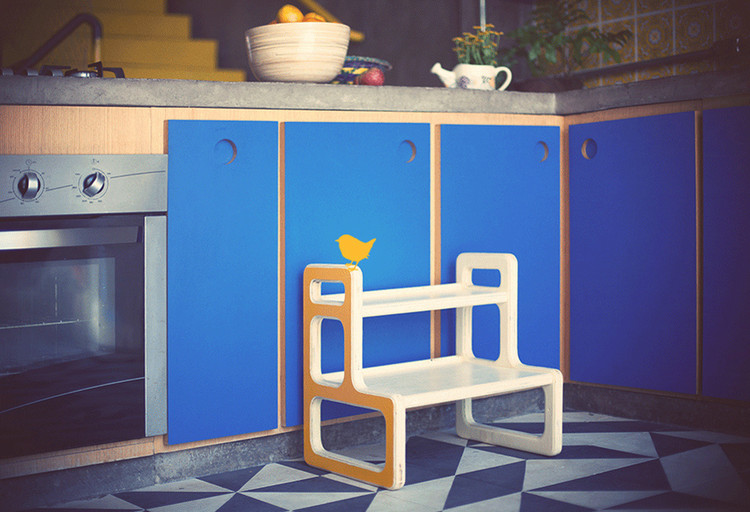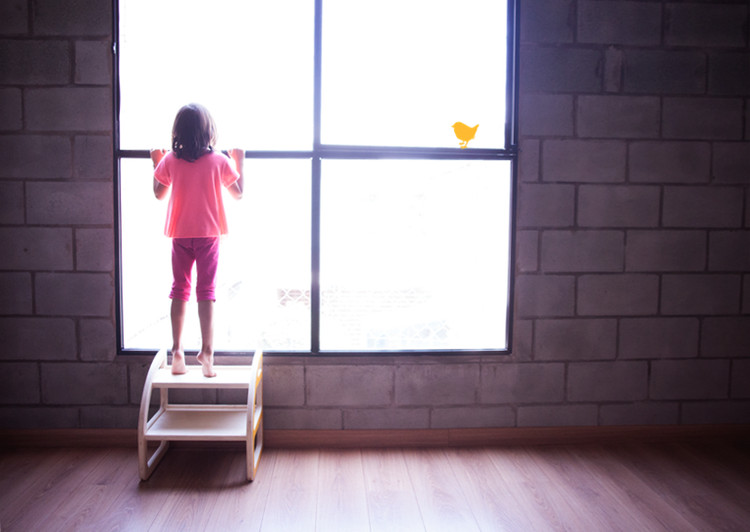
Maria Montessori began to develop her educational method at the beginning of the 20th century. In general terms, the method is a scientific pedagogy that promotes an education that positively contributes to the development of children's brains, respecting their individuality and stimulating their autonomy, self-esteem, and self-confidence.
Although the method was created in the last century, science is currently beginning to test much of the information investigated by Maria Montessori. For this reason, it is increasingly being applied to architecture for children’s educational spaces, improving the quality of children's learning and development and providing them with better tools for their future lives.

Among the skills and benefits that the method can bring to children’s development are concentration, creativity, curiosity, a sense of justice, and emotional intelligence.
The method is fairly comprehensive and therefore difficult to summarize in a single article, but a core facet worth mentioning is its ‘three pillars.’ The child, the conscious adult, and the prepared environment should always be together, connected. One doesn't work without the other. To carry out the method effectively, a conscious adult is needed who understands child development, because it makes no sense to transform the physical environment without offering the child a calm, peaceful, patient, welcoming, harmonious, and respectful emotional atmosphere (both for boys and girls and for adults).


In 2011, the Wall Street Journal wrote an article about the 'Montessori Mafia', identifying some personalities who studied in schools that follow the philosophy of the method. Among them:
- Mark Zuckerberg, founder of Facebook.
- Larry Page and Sergey Brin, founders of Google.
- Bill Gates, founder of Microsoft.
- Jimmy Wales, founder of Wikipedia.
- Peter Drucker, known as the father of modern administration.
- Jeffrey Bezos, founder of Amazon.
- Anne Frank.
- Gabriel Garcia Marquez, Nobel Prize for Literature winner.
- Members of the British Royal Family.

Knowing that so many outstanding and successful figures were raised according to this methodology, one question becomes extremely relevant: who was Maria Montessori?
In a nutshell: the daughter of a feminist, Maria Montessori was always encouraged to take on challenges. She participated in engineering courses in classrooms dominated by men, though she later found that she loved biology and decided to study medicine. At that time it was necessary to ask permission from the rector of the university; once again, male territory. Despite the obstacles along the way, Maria was the third woman to graduate in Italy, becoming one of the first women to practice professionally. She finally opted to go into the field of Psychiatry.

In 1898, she defended a thesis in which she stated that the main cause for delays in the learning and behavior of children was that their environment didn't contain the appropriate stimuli for their development, thus beginning her studies on the importance of the prepared environment. She began studying education, making important discoveries while observing children with special needs. She tried old methods and created new ones until she decided to dedicate herself exclusively to this area: childhood.
In 1907, Maria was invited to coordinate the first Casa Dei Bambini (Home for Children), a space created without pretensions that turned out to be one of the most important educational experiments of the time. The space was located in an old commercial shed, and at the beginning of its use, there was still much office furniture. Maria set to cut the legs off of all this furniture so that the children were able to access them.

After the recognized success of her educational work with Italian boys and girls, Montessori made trips to spread her findings through courses and conferences. She also opened schools, trained teachers, wrote books and articles. She was in great demand and gave interviews wherever she went. At 76 years old in 1947, Montessori gave a conference on "Education and peace" for UNESCO. Two years later she received her first nomination (of three) for the Nobel Peace Prize. She died in the Netherlands in 1952, but her legacy and discoveries remain more alive than ever.
A more just and charitable attitude would create an environment in which children were free from the oppression of adults, where they could really prepare for life. The school should feel like a shelter from the storm or an oasis in the middle of a desert, a safe haven for the child’s spirit (Maria Montessori)
.jpg?1574804498)
Another important point of the method is the Montessori room. It's a very important prepared environment, but to apply the method effectively it's necessary to design accessible and safe spaces in every children’s space, both in their own home and in public spaces.
When designing, we recommend taking into account the following features:
- Simplicity
Boys and girls don't need much. It's recommended to prioritize light colors and natural light. - Minimalism
Too many options (such as colors or toys) in the same environment can cause confusion. Therefore, it's recommended to select very few options and facilitate the development of decision-making capacities. - Organization
When external environments are organized, the internal organization of the child (and their reasoning) tends to flow more easily as well. - Accessibility
Everything must be designed so that children can move and interact through space without the intervention of an adult. However, the presence of a conscious adult is always recommended. - Security
A well-prepared environment must be explorable. In order for a child to be free to explore without risk, a safe environment must be prepared for them. - Silence
A well-prepared environment should favor physical autonomy and emotional autonomy (choices), in addition to encouraging concentration. Therefore, this room should be located in the quietest area of the house. It's recommended to avoid electronic devices to create a quiet environment.

It is suggested to start with the bedroom because this is where the child will spend most of their time: sleeping, playing with objects, and doing activities. But don't focus only on the bedroom: prepare all environments to make them accessible! Kitchens, living rooms, bathrooms, and terraces can all include objects that provide security and freedom to children. We share some elements that can help projects in this regard:
- Mirror and grab bar
It's important to have a mirror to stimulate the child’s recognition of their own body and face, identifying facial expressions and, subsequently, feelings and emotions. In addition, the mirror helps them realize that they and their parents are different human beings (believe me, they go through this period of confusion) and additionally helps them discover new movements. The installation height of the mirror and the support bar depends on the child's development (crawls, sits, walks?) and their height. The support bar will help the child gain stability until they can stand up, and after walking the bar will accelerate the process to reach balance.

There are acrylic mirrors and it is possible to improvise a support bar with a curtain rod, but if possible, it's recommended to buy products designed specifically for children, as they will guarantee additional safety. For example, Brazilian company Smirna Montessori developed an adjustable and functional mirror for children from 0 to 6 years old, with a bar included.
- Bed
Maria Montessori believed that the Montessori room should be simple, with light colors and few objects - that is, it should be cheaper than traditional children's rooms. With respect to the bed, the primary focus of the bedroom, it's essential that it allows freedom of movement. Depending on the age group, the best solution may be simply a mattress on the floor or a low bed.

- Carpet
This is not a "Montessori" recommendation, however, it's good to place a carpet next to the bed because it's not pleasant to step on the cold floor when you wake up. If the child already wears slippers when they get up or if the bedroom floor is wooden, this recommendation is less necessary but still should be a consideration. Another option is rubber floors, which, in addition to protecting against the cold, also supports stability and safety as the child moves through the environment, since a conventional carpet can slide very easily.
With these objectives in mind, Bugoo Baby's Folder-Mat product could also deliver high aesthetic value to the project.
.jpg?1574455866)
Furniture
Montessori emphasized the importance of using child-adapted and accessible furniture to children's daily lives so that they would feel capable of getting everything they need by themselves. Some of the recommended furniture includes:

- Wardrobe at their height, making available two or three changes of clothes to adapt to specific climates or occasions. The main point of this practice is to encourage and "train" their ability to make small decisions on a daily basis. This will help them a lot in the future when they have to make more important decisions.
- Low shelf to store toys and other recreational items.
- Activity table and chair, ideal for solo activities, where a high level of concentration is required.
- Small staircase, which functions as the main element for the autonomy of children in their homes. A small staircase allows children to reach the sink in the bathroom, the kitchen counter, or a book on a higher shelf.
There are currently several companies that are concerned with developing pieces that provide accessibility to children without sacrificing design, such as Cuchi Móveis Infantis in Brazil.


- Decor
Images, photographs, and illustrations that are usually hung on the walls are useful because they embellish and arouse interest in art. But they only fulfill this role if they are hung at a height that the child can see and appreciate. Choose illustrations that match reality, such as animals, fruits, places, and people. And if the environment is designed for a baby, use more high contrast geometric images, especially in black and white.

- Hangers and Shelves
In addition to facilitating organization, hangers and shelves located on the walls, at the right height, allow children to hang backpacks, coats, and umbrellas. The order in which they are hung must be respected when the child is not present.

- Safety Items
These are not necessarily articles for projects that aim to implement the Montessori philosophy, but rather to all those who care about the physical safety of the child. Corner guards, drawer seals, and window protection meshes are some of them.

It's important to highlight the influence that Maria Montessori had, from her first studies to her influence on the lives of children around the world. In short, preparing the environment at home is crucial, but it's also important that children have safe and stimulating outdoor experiences. Visits to parks, squares, and beaches are very welcome during early childhood and are an essential complement to the techniques promoted by Montessori.

Neste caso, informe-se e apoie iniciativas como a Urban 95, administrada pela Fundação Bernard van Leer cujo objetivo principal é prover assistência técnica e financeira no apoio a iniciativas em cidades parceiras. Um de seus propósitos é contribuir com o aumento das opções de mobilidade das famílias, para que se movam com segurança em suas comunidades.
Você pode ler mais sobre a Urban 95 no artigo "3 Projetos brasileiros entre os vencedores do Urban95 Challenge, para melhoria das cidades para as crianças (e para todos)".
References
- MIGLIANI, Audrey. Guia para um verdadeiro quarto montessoriano. Available in https://seuambienteprepara.wixsite.com/ambientepreparado
- 'É para ser simples', de Gabriel Salomão no Lar Montessori. Available in https://larmontessori.com/2014/04/04/e-pra-sersimples.
- 'O que realmente importa', de Gabriel Salomão no Lar Montessori. Available in https://larmontessori.com/2014/03/10/oque-realmente-importa.
- 'A vida de Maria Montessori', de Gabriel Salomão no Lar Montessori. Available in https://larmontessori.com/mariamontessori.
- 'Programa de 5 semanas para Montessori em Casa' do Lar Montessori. Available in https://larmontessori.com/2018/01/06/programa-de-5semanas-para-montessori-em-casa-gratuito.
- Sobre Brinquedos que Brincam Sozinhos” por Gabriel Salomão, do Lar Montessori. Available in https://larmontessori.com/2014/05/03/sobrebrinquedos-que-brincam-sozinhos.
- https://blogs.wsj.com/ideas-market/2011/04/05/the-montessori-mafia/. Accessed on November 22, 2019
Editor's Note: This article was originally published on December 25, 2019.









.jpg?1574455849)






.jpg?1574455902)
.jpg?1574804498)








.jpg?1574455857)